不定式省略to的规则
- 格式:doc
- 大小:23.00 KB
- 文档页数:2

不定式符号to的省略不定式符号to的省略1.不定式作宾补省to:在英语中有的动词用不定式做宾补时需要省略不定式符号to。
可以这样进行记忆如下动词:二感觉:feel;perceive二听:hear; listen to;三让:have ; let ; make [have or let及少用被动] 五看:see; watch; notice; observe; look at。
共12个。
Whenever something is wrong with you, please do let me know.I will have the students write a passage about Internet.On seeing the young child fall into the lake, John sprang to his feet, and went to the rescue.Who are you going to have type this letter for you?Who would you rather have clean the room?It seemed so long before he heard the stone hit the water.Modesty helps one make progress while conceit makes one lag behind. 谦虚使人进步,骄傲使人落后。
He did not perceive anyone come in.他没有觉察到有人进来。
如果上述动词用被动语态时,不定式符号to不能省略。
Paul doesn't have to be made to learn. He always works hard.The fat boy was made to take more exercise to lose weight.He was angry to be made to pay double the price for it.The thief was perceived to steal into the house.有人看见小偷溜进那房子里去了。
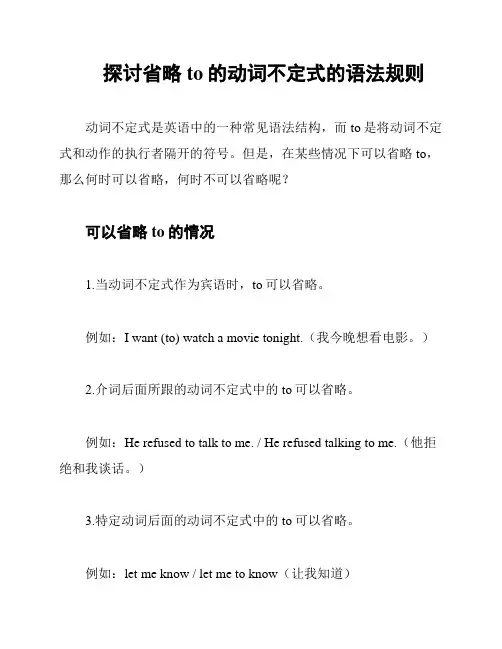
探讨省略to的动词不定式的语法规则
动词不定式是英语中的一种常见语法结构,而to是将动词不定式和动作的执行者隔开的符号。
但是,在某些情况下可以省略to,那么何时可以省略,何时不可以省略呢?
可以省略to的情况
1.当动词不定式作为宾语时,to可以省略。
例如:I want (to) watch a movie tonight.(我今晚想看电影。
)
2.介词后面所跟的动词不定式中的to可以省略。
例如:He refused to talk to me. / He refused talking to me.(他拒绝和我谈话。
)
3.特定动词后面的动词不定式中的to可以省略。
例如:let me know / let me to know(让我知道)
不可以省略to的情况
1.当动词不定式作为主语或表语时,to不可省略。
例如:To be or not to be, that is the question.(生存还是毁灭,这是一个问题。
)
2.在被动语态中,to不可省略。
例如:The building is going to be demolished.(这座建筑将要被拆除。
)
3.在复合宾语结构中,to不可省略。
例如:I want you to help me.(我想让你帮我。
)
综上所述,省略to的动词不定式在特定情况下是可以的,但是也需要视情况而定,不能一味地省略。
掌握好省略to的动词不定式的语法规则,可以有效提高英语的表达水平。
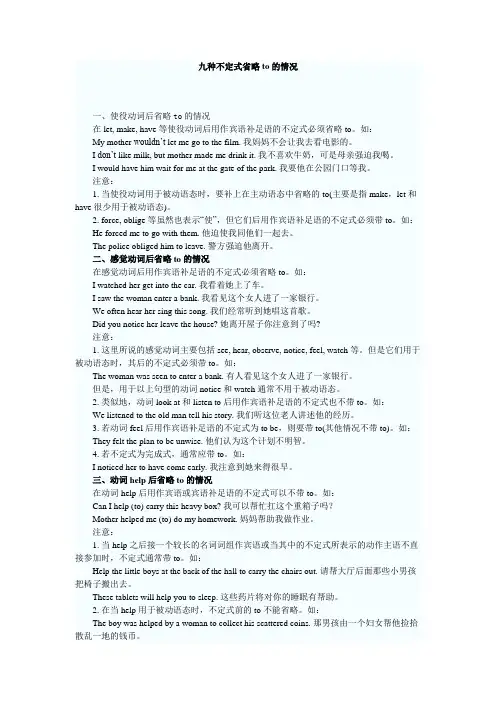
九种不定式省略to的情况一、使役动词后省略to的情况在let, make, have等使役动词后用作宾语补足语的不定式必须省略to。
如:My mother wouldn’t let me go to the film. 我妈妈不会让我去看电影的。
I don’t like milk, but mother made me drink it. 我不喜欢牛奶,可是母亲强迫我喝。
I would have him wait for me at the gate of the park. 我要他在公园门口等我。
注意:1. 当使役动词用于被动语态时,要补上在主动语态中省略的to(主要是指make,let和have很少用于被动语态)。
2. force, oblige等虽然也表示“使”,但它们后用作宾语补足语的不定式必须带to。
如:He forced me to go with them. 他迫使我同他们一起去。
The police obliged him to leave. 警方强迫他离开。
二、感觉动词后省略to的情况在感觉动词后用作宾语补足语的不定式必须省略to。
如:I watched her get into the car. 我看着她上了车。
I saw the woman enter a bank. 我看见这个女人进了一家银行。
We often hear her sing this song. 我们经常听到她唱这首歌。
Did you notice her leave the house? 她离开屋子你注意到了吗?注意:1. 这里所说的感觉动词主要包括see, hear, observe, notice, feel, watch等。
但是它们用于被动语态时,其后的不定式必须带to。
如:The woman was seen to enter a bank. 有人看见这个女人进了一家银行。
但是,用于以上句型的动词notice 和watch通常不用于被动语态。
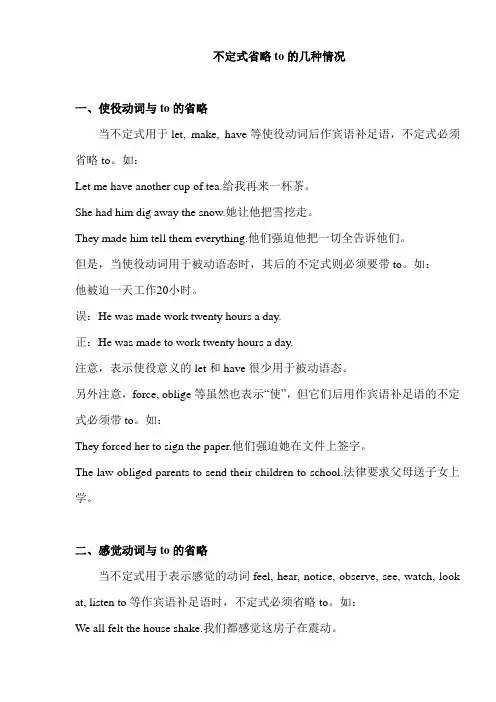
不定式省略to的几种情况一、使役动词与to的省略当不定式用于let, make, have等使役动词后作宾语补足语,不定式必须省略to。
如:Let me have another cup of tea.给我再来一杯茶。
She had him dig away the snow.她让他把雪挖走。
They made him tell them everything.他们强迫他把一切全告诉他们。
但是,当使役动词用于被动语态时,其后的不定式则必须要带to。
如:他被迫一天工作20小时。
误:He was made work twenty hours a day.正:He was made to work twenty hours a day.注意,表示使役意义的let和have很少用于被动语态。
另外注意,force, oblige等虽然也表示“使”,但它们后用作宾语补足语的不定式必须带to。
如:They forced her to sign the paper.他们强迫她在文件上签字。
The law obliged parents to send their children to school.法律要求父母送子女上学。
二、感觉动词与to的省略当不定式用于表示感觉的动词feel, hear, notice, observe, see, watch, look at, listen to等作宾语补足语时,不定式必须省略to。
如:We all felt the house shake.我们都感觉这房子在震动。
I heard him go down the stairs.我听见他下楼了。
Did you notice her leave the house?她离开屋子你注意到了吗?I watched her get into the car.我看着她上了车。
但是,当feel后用作宾语补足语的不定式为to be时,则不能省略to。
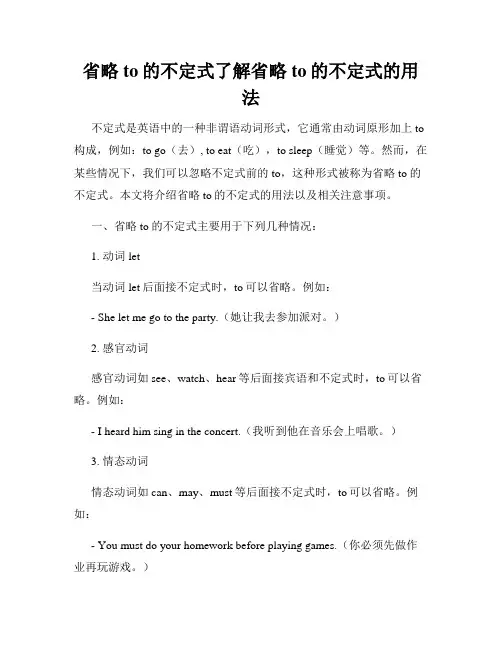
省略to的不定式了解省略to的不定式的用法不定式是英语中的一种非谓语动词形式,它通常由动词原形加上to 构成,例如:to go(去), to eat(吃),to sleep(睡觉)等。
然而,在某些情况下,我们可以忽略不定式前的to,这种形式被称为省略to的不定式。
本文将介绍省略to的不定式的用法以及相关注意事项。
一、省略to的不定式主要用于下列几种情况:1. 动词let当动词let后面接不定式时,to可以省略。
例如:- She let me go to the party.(她让我去参加派对。
)2. 感官动词感官动词如see、watch、hear等后面接宾语和不定式时,to可以省略。
例如:- I heard him sing in the concert.(我听到他在音乐会上唱歌。
)3. 情态动词情态动词如can、may、must等后面接不定式时,to可以省略。
例如:- You must do your homework before playing games.(你必须先做作业再玩游戏。
)4. 动词help当动词help后面接不定式时,to可以省略。
例如:- He helped me carry the heavy boxes.(他帮我搬运沉重的箱子。
)二、需要注意的细节问题:1. 第一个动词是make、let、help、see、hear、watch或feel时,后面的动词不定式可以省略to;2. 在句子中,第一个动词是感官动词或情态动词时,后面的动词不定式可以省略to;3. 省略to的不定式只适用于动词不定式的主动形式,不能用于被动形式;4. 不定式的完整形式“to + 动词原形”通常更正式,所以在正式场合或文学作品中,建议使用完整形式。
三、案例分析:1. They helped me (to) clean the house before the guests arrived.(他们帮我在客人到来之前打扫了房间。
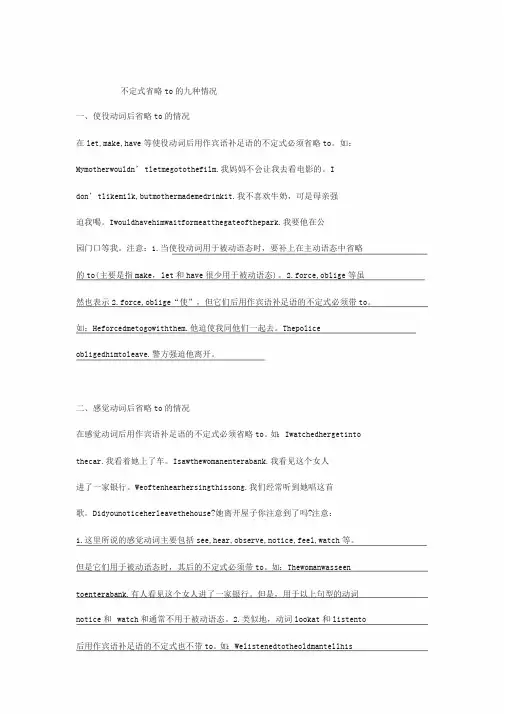
不定式省略to的九种情况一、使役动词后省略to的情况在let,make,have等使役动词后用作宾语补足语的不定式必须省略to。
如:Mymotherwouldn’tletmegotothefilm.我妈妈不会让我去看电影的。
Idon’tlikemilk,butmothermademedrinkit.我不喜欢牛奶,可是母亲强迫我喝。
Iwouldhavehimwaitformeatthegateofthepark.我要他在公园门口等我。
注意:1.当使役动词用于被动语态时,要补上在主动语态中省略的to(主要是指make,let和have很少用于被动语态)。
2.force,oblige等虽然也表示2.force,oblige“使”,但它们后用作宾语补足语的不定式必须带to。
如:Heforcedmetogowiththem.他迫使我同他们一起去。
Thepolice obligedhimtoleave.警方强迫他离开。
二、感觉动词后省略to的情况在感觉动词后用作宾语补足语的不定式必须省略to。
如:Iwatchedhergetinto thecar.我看着她上了车。
Isawthewomanenterabank.我看见这个女人进了一家银行。
Weoftenhearhersingthissong.我们经常听到她唱这首歌。
Didyounoticeherleavethehouse?她离开屋子你注意到了吗?注意:1.这里所说的感觉动词主要包括see,hear,observe,notice,feel,watch等。
但是它们用于被动语态时,其后的不定式必须带to。
如:Thewomanwasseen toenterabank.有人看见这个女人进了一家银行。
但是,用于以上句型的动词notice和watch和通常不用于被动语态。
2.类似地,动词lookat和listento 后用作宾语补足语的不定式也不带to。
如:Welistenedtotheoldmantellhissto r y .我们听这位老人讲述3.若动词feel 后用作宾语补足语的不定 式为t o b e ,t o (其他情to)。
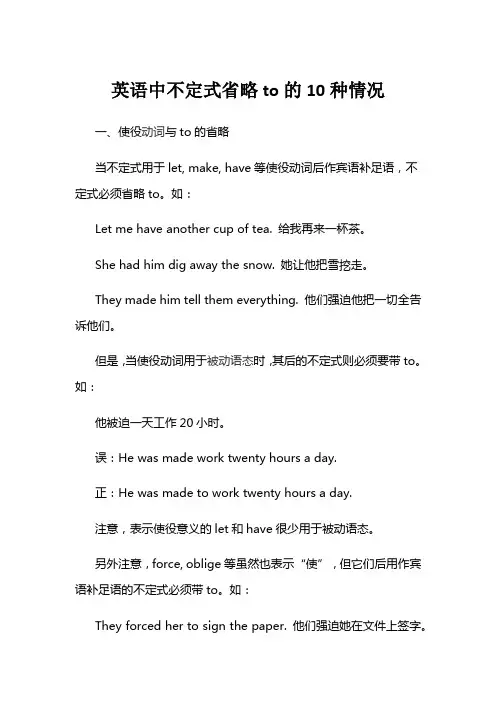
英语中不定式省略to的10种情况一、使役动词与to的省略当不定式用于let, make, have等使役动词后作宾语补足语,不定式必须省略to。
如:Let me have another cup of tea. 给我再来一杯茶。
She had him dig away the snow. 她让他把雪挖走。
They made him tell them everything. 他们强迫他把一切全告诉他们。
但是,当使役动词用于被动语态时,其后的不定式则必须要带to。
如:他被迫一天工作20小时。
误:He was made work twenty hours a day.正:He was made to work twenty hours a day.注意,表示使役意义的let和have很少用于被动语态。
另外注意,force, oblige等虽然也表示“使”,但它们后用作宾语补足语的不定式必须带to。
如:They forced her to sign the paper. 他们强迫她在文件上签字。
The law obliged parents to send their children to school. 法律要求父母送子女上学。
二、感觉动词与to的省略当不定式用于表示感觉的动词feel, hear, notice, observe, see, watch, look at, listen to等作宾语补足语时,不定式必须省略to。
如:We all felt the house shake. 我们都感觉这房子在震动。
I heard him go down the stairs. 我听见他下楼了。
Did you notice her leave the house? 她离开屋子你注意到了吗?I watched her get into the car. 我看着她上了车。
但是,当feel后用作宾语补足语的不定式为to be时,则不能省略to。
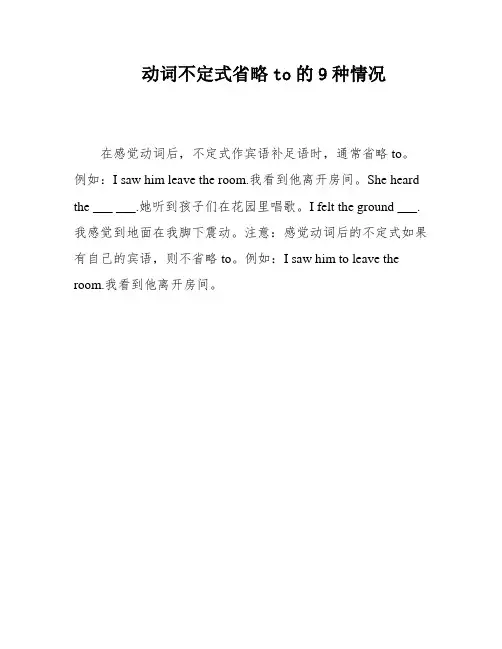
动词不定式省略to的9种情况在感觉动词后,不定式作宾语补足语时,通常省略to。
例如:I saw him leave the room.我看到他离开房间。
She heard the ___ ___.她听到孩子们在花园里唱歌。
I felt the ground ___.我感觉到地面在我脚下震动。
注意:感觉动词后的不定式如果有自己的宾语,则不省略to。
例如:I saw him to leave the room.我看到他离开房间。
注意:1.当help之后接一个较长的名词词组作宾语或当其中的不定式所表示的动作主语不直接参加时,不定式通常带to。
例如:Help the little boys at the back of the hall to carry the chairs out.请帮大厅后面那些小男孩把椅子搬出去。
These tablets will help you to sleep.这些药片将对你的睡眠有帮助。
2.在当help用于被动语态时,不定式前的to不能省略。
例如:Help is needed to clean up the mess.需要帮助清理这个混乱。
___ ___.Fourth。
n of "to" after "why (not)。
"___ infinitive after "why (not)。
" cannot be followed by "to"。
For example。
"Why go with him?" and "Why not ask the teacher?" In the sentence "Why not try to expand your story into a novel?"。
it should be "Why not try expanding your story into a novel?"Fifth。
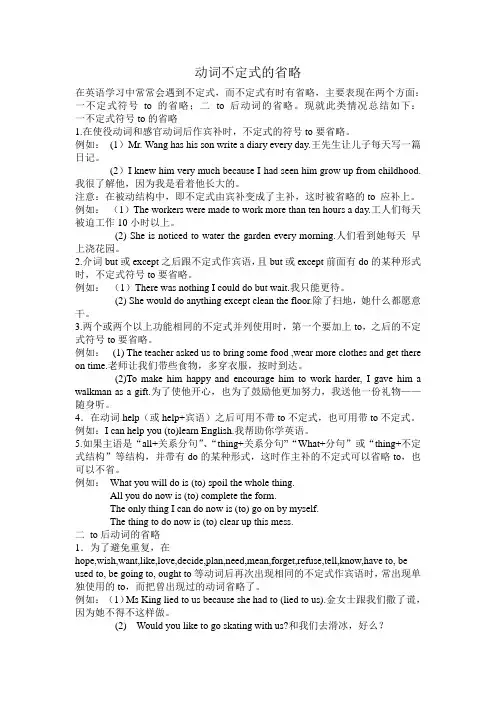
动词不定式的省略在英语学习中常常会遇到不定式,而不定式有时有省略,主要表现在两个方面:一不定式符号to的省略;二to后动词的省略。
现就此类情况总结如下:一不定式符号to的省略1.在使役动词和感官动词后作宾补时,不定式的符号to要省略。
例如:(1)Mr. Wang has his son write a diary every day.王先生让儿子每天写一篇日记。
(2)I knew him very much because I had seen him grow up from childhood.我很了解他,因为我是看着他长大的。
注意:在被动结构中,即不定式由宾补变成了主补,这时被省略的to 应补上。
例如:(1)The workers were made to work more than ten hours a day.工人们每天被迫工作10小时以上。
(2) She is noticed to water the garden every morning.人们看到她每天早上浇花园。
2.介词but或except之后跟不定式作宾语,且but或except前面有do的某种形式时,不定式符号to要省略。
例如:(1)There was nothing I could do but wait.我只能更待。
(2) She would do anything except clean the floor.除了扫地,她什么都愿意干。
3.两个或两个以上功能相同的不定式并列使用时,第一个要加上to,之后的不定式符号to要省略。
例如:(1) The teacher asked us to bring some food ,wear more clothes and get there on time.老师让我们带些食物,多穿衣服,按时到达。
(2)To make him happy and encourage him to work harder, I gave him a walkman as a gift.为了使他开心,也为了鼓励他更加努力,我送他一份礼物——随身听。
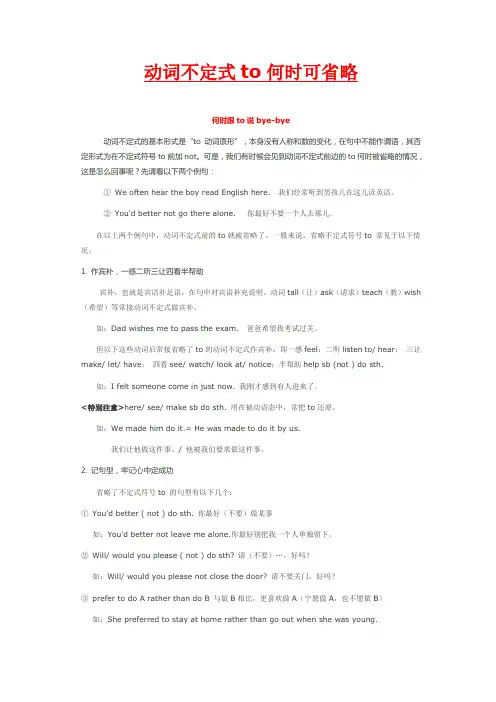
动词不定式to何时可省略何时跟to说bye-bye动词不定式的基本形式是“to 动词原形”,本身没有人称和数的变化,在句中不能作谓语,其否定形式为在不定式符号to前加not。
可是,我们有时候会见到动词不定式前边的to何时被省略的情况,这是怎么回事呢?先请看以下两个例句:①We often hear the boy read English here. 我们经常听到男孩儿在这儿读英语。
②You'd better not go there alone. 你最好不要一个人去那儿。
在以上两个例句中,动词不定式前的to就被省略了。
一般来说,省略不定式符号to 常见于以下情况:1.作宾补,一感二听三让四看半帮助宾补,也就是宾语补足语,在句中对宾语补充说明。
动词tall(让)ask(请求)teach(教)wish (希望)等常接动词不定式做宾补。
如:Dad wishes me to pass the exam. 爸爸希望我考试过关。
但以下这些动词后常接省略了to的动词不定式作宾补:即一感feel;二听listen to/ hear;三让make/ let/ have;四看see/ watch/ look at/ notice;半帮助help sb (not ) do sth.如:I felt someone come in just now. 我刚才感到有人进来了。
<特别注意>here/ see/ make sb do sth. 用在被动语态中,常把to还原。
如:We made him do it.= He was made to do it by us.我们让他做这件事。
/ 他被我们要求做这件事。
2.记句型,牢记心中定成功省略了不定式符号to 的句型有以下几个:①You'd better ( not ) do sth. 你最好(不要)做某事如:You'd better not leave me alone.你最好别把我一个人单独留下。
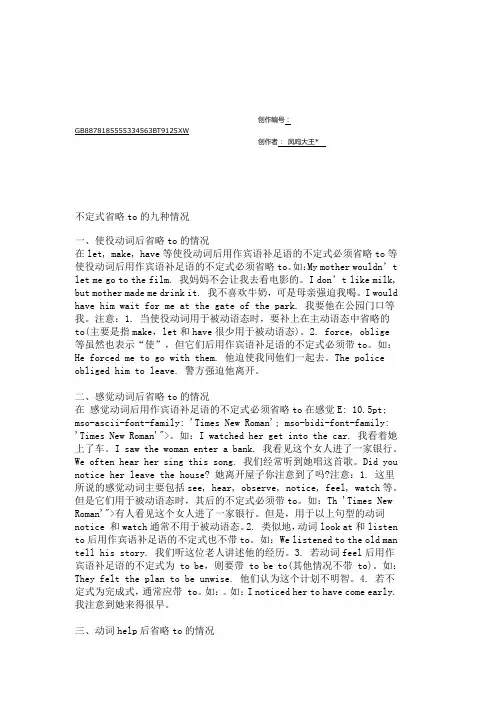
创作编号:GB8878185555334563BT9125XW创作者:凤呜大王*不定式省略to的九种情况一、使役动词后省略to的情况在let, make, have等使役动词后用作宾语补足语的不定式必须省略to等使役动词后用作宾语补足语的不定式必须省略to。
如:My mother wouldn’t let me go to the film. 我妈妈不会让我去看电影的。
I don’t like milk, but mother made me drink it. 我不喜欢牛奶,可是母亲强迫我喝。
I would have him wait for me at the gate of the park. 我要他在公园门口等我。
注意:1. 当使役动词用于被动语态时,要补上在主动语态中省略的to(主要是指make,let和have很少用于被动语态)。
2. force, oblige等虽然也表示“使”,但它们后用作宾语补足语的不定式必须带to。
如:He forced me to go with them. 他迫使我同他们一起去。
The police obliged him to leave. 警方强迫他离开。
二、感觉动词后省略to的情况在感觉动词后用作宾语补足语的不定式必须省略to在感觉E: 10.5pt; mso-ascii-font-family: 'Times New Roman'; mso-bidi-font-family: 'Times New Roman'">。
如:I watched her get into the car. 我看着她上了车。
I saw the woman enter a bank. 我看见这个女人进了一家银行。
We often hear her sing this song. 我们经常听到她唱这首歌。
Did you notice her leave the house? 她离开屋子你注意到了吗?注意:1. 这里所说的感觉动词主要包括see, hear, observe, notice, feel, watch等。
省略to的不定式了解省略to的不定式的使用规则不定式是英语中一种非谓语动词形式,主要用于表示动作的概念,具有名词、形容词和副词的特点。
在不定式中,to是一个常见的引导词,但有时也可以被省略。
本文将介绍省略to的不定式以及其使用规则。
一、省略to的情况1. 动词感官宾语:常见的有see, hear, watch, feel, notice等动词。
例如:- I heard him sing.(我听到他唱歌。
)- Did you see her leave?(你看见她离开了吗?)2. 情态动词后的动词原形:情态动词包括can, may, might, must, shall, will等。
例如:- She can swim.(她会游泳。
)- You must finish your homework.(你必须完成你的作业。
)3. make, let, help后的动词原形:这些动词可以引导不带to的不定式作宾补。
例如:- My mother let me go to the party.(我妈妈让我去参加派对。
)- I can help you clean the room.(我可以帮你打扫房间。
)4. have, let, make, help后的动词过去分词:这些动词也可以引导过去分词作宾补。
例如:- I had my car washed.(我让我的车洗了。
)- He made me laugh.(他让我笑了。
)5. 表示感觉、看法或意见的动词:常见的有feel, hear, let, make, see, notice, watch等。
例如:- I felt the ground shake.(我感觉到地面在震动。
)- Did you see him leave?(你看见他离开了吗?)二、注意事项1. 若省略to,动词后的宾语仍然要保留。
例如:- I let him go.(我让他走。
)2. 省略to后的动词原形仍然带有动作的概念,不能用于现在进行时和完成时态。
不定式省略t o的九种情况一、使役动词后省略to的情况在let, make, have等使役动词后用作宾语补足语的不定式必须省略to等使役动词后用作宾语补足语的不定式必须省略to。
如:My mother wouldn’t let me go to the film. 我妈妈不会让我去看电影的。
I don’t like milk, but mother made me drink it. 我不喜欢牛奶,可是母亲强迫我喝。
I would have him wait for me at the gate of the park. 我要他在公园门口等我。
注意:1. 当使役动词用于被动语态时,要补上在主动语态中省略的to(主要是指make,let和have 很少用于被动语态)。
2. force, oblige等虽然也表示“使”,但它们后用作宾语补足语的不定式必须带to。
如:He forced me to go with them. 他迫使我同他们一起去。
The police obliged him to leave. 警方强迫他离开。
二、感觉动词后省略to的情况在感觉动词后用作宾语补足语的不定式必须省略to在感觉E: 10.5pt;mso-ascii-font-family: 'Times New Roman'; mso-bidi-font-family: 'Times New Roman'">。
如:I watched her get into the car. 我看着她上了车。
I saw the woman enter a bank. 我看见这个女人进了一家银行。
We often hear her sing this song. 我们经常听到她唱这首歌。
Did you notice her leave the house? 她离开屋子你注意到了吗?注意:1. 这里所说的感觉动词主要包括see, hear, observe, notice, feel, watch等。
探讨省略to的动词不定式的语法规则动词不定式是表示动作、状态或目的的一种形式。
在英语中,有时候我们可以省略动词不定式前面的to。
本文将探讨这种省略to 的动词不定式的语法规则。
省略的情况一般来说,我们可以省略to的动词不定式有以下几种情况:1. 动词see, hear, feel, watch, make, let, notice, observe等后面的宾语是名词或代词时,可以省略to。
例如:- I heard her sing.(我听到她唱歌。
)- He noticed me leave.(他注意到我离开。
)2. 一些常见的动词如want, need, would like, prefer, decide等后面的动词不定式可以省略to。
例如:- She wants to go.(她想去。
)- I need to finish my homework.(我需要完成作业。
)3. 当两个动词连用时,第二个动词不定式可以省略to。
例如:- He made me cry.(他让我哭。
)- They let us go.(他们让我们走。
)省略to的注意事项在使用省略to的动词不定式时,需要注意以下几点:1. 当省略to的动词不定式作为主语时,动词要用单数形式。
例如:- To swim is my hobby.(游泳是我的爱好。
)2. 如果省略to的动词不定式的主语是第三人称单数,则要使用动词的第三人称单数形式。
例如:- He makes me laugh.(他让我笑。
)3. 如果省略to的动词不定式的主语是复数形式,则要使用动词的原形。
例如:- They make us happy.(他们让我们快乐。
)总结省略to的动词不定式是英语语法中的一种常见现象,但需要根据具体的语境和动词使用情况来决定是否可以省略to。
通过本文的讨论,我们对省略to的动词不定式的语法规则有了更清晰的认识。
希望本文对您有所帮助!。
关于动词不定式中省略to的几种情况福建省莆田市文献中学王紫To是不定式常常带有的符号,但在下面几种情况,它常常被省略:一、动词help后省略to的情况在动词help后用作宾语或宾语补足语的不定式可以带to也可以不带to。
如:Can I help (to) carry this heavy box? 我可以帮忙扛这个重箱子吗?Mother helped mo (to) do my homework. 妈妈帮助我做作业。
[注意]:1、当help之后接一个较长的名词词组作宾语或当其中的不定式所表示的动作主语不直接参与时,不定式通常带to。
如:Help the little boys at the back of the hall to carry the chairs out.请帮大厅后面那些小男孩把椅子搬出去。
These tablets will help you to sleep. 这些药片将对你的睡眠有帮助。
2、当help用于被动语态时,不定式前的to不能省略。
如:The boy was helped by a woman to collect his scattered coins.一个妇女帮那个男孩捡拾散落一地的钱币。
二、Why (not) …后省略to的情况在Why(not)…?之后的不定式不能带to。
如:Why go with him? 为什么要同他一起去?Why not ask the teacher? 为什么不去问问老师?Why not try to expand your story into a novel? 你怎么不把你的故事扩展成小说呢?三、使役动词后省略to的情况在let, make,have等使役动词后用作宾语补足语的不定式必须省略to。
如:My mother wouldn’t let me go to the movie.我妈妈不会让我去看电影的。
I don’t like milk, but my mother made me drink it.我不喜欢牛奶,可是我妈妈强迫我喝。
动词不定式省略to的情况1.主语部分有to do ,系动词is 或was 时,作表语的不定式通常省去to。
如:The only thing you have to do is press the button.你必须做的唯一事情是按按钮。
2.作介词but ,expect ,besides 的宾语,前面又有实意动词do 时,不定式通常省去to. 如:He said that Chen Shuibian had nothing to do except push a pro-“independence”timetable.他说陈水扁除了推进支持“独立”的时间表外,什么也没有做。
3.主语部分暗含to do,表语中的不定式通常省去to。
如:All I want (to do) is go to school and study hard .我想要(做)的就是上学,努力学习。
4.当两个或多个不定式并列时,其后的不定式符号可以省略,但有对比关系时不可省略。
如:It is easier to say than to do .5.在would rather…than…等结构中,不定式符号常常要省略. 如:I would rather stay at home than go to see a film.我宁愿呆在家也不愿去看电影。
6.在see ,watch ,notice ,hear, listen to ,look at ,feel ,have, make, let ,observe 等词后作宾语补足语时省略不定式符号to;why (not) do 结构中, 不定式不带to.(1) I saw her enter the room . 我看见她进入了房间(2) Why not join us ?为什么不加入到我们的行列里来呢?。
不定式省略to的规则
山东省民族中等专业学校赵敏焦燕
不定式一般带有符号to,它不能单独作谓语,在省去to以后,可以与助动词、情态动词一起构成合成谓语。
这是常见的用法。
此外,在下列情况下,不定式也需将to省掉。
1、不定式与一些固定词组构成合成谓语时,必须省去to。
常见的固定词组有:
had better 最好
would/had rather+v(than+v) 宁可(前者),也不(后者)
would/had sooner+v(than +v)
can/could not but 不得不,禁不住,非……不可
can/could not choose but
do nothing but+v 只是
do no/not more than+v 仅仅
could do nothing else than+v 不得不
2、在一些表示感观、使役意义的动词后面跟不定式作宾语补足语时,不定式须省去to。
常见的有:make, let, have;see,watch,notice,look at ,observe;hear,listen to ,help,feel等。
3、在介词but,except,besides,than等前面若有实意动词do时,常用不带to的不定式作介词宾语。
如果没有do,不可省to。
例如:
Tom did nothing except clean the dishes.
He did nothing else than laugh.
What do you like to do besides swim?
He seldom goes there except to look at Mary.
4、在动词help后面跟不定式作宾语时,常常省去to(也可以带to)。
例如:
Can I help carry it for you?
They often help ( to ) sweep the floors.
5、在主–系–表句型中,如果句中主语部分有实意动词do,作表语的不定式可以省去to。
例如:
All she did was turn off the light.
6、在go,come,run,hurry up,stay,wait,try等词之后常用“and+不带to的不定式”。
在这一结构中,and后的不定式起目的状语作用。
它主要用于祈使句,也可用在陈述句中。
Go and tell them to stop talking.
Come and have a rest.
Stay and have dinner.
Try and get some water.
7、and,or可以连接并列的不定式,第二个不定式前通常省去to ;另外在第一个不定式后跟多个结构上并列的不定式时,通常第一个不定式带to,后
面的可省去to。
例如:
In the old days, he never got enough to eat or wear.
Youngsters should dare to think, speak and act.
We are anxious to learn from other countries and share their experience.
8、在以why或why not开头的句子中,why(not)之后不定式不带to。
例如
Why not go out for a walk?
Why do you come here so late?。